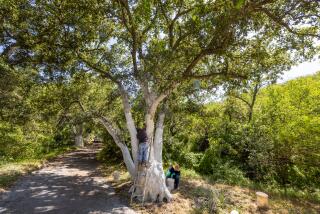Invasion of the Killer Worms
- Share via
DULUTH, Minn. — The bluebead lily and red bainberry plants were few, the forest floor nearly denuded and still. When the solution of pulverized mustard seed and water seeped in, though, the ground began to churn.
Up came the worms, wriggling and writhing, Lumbricus terrestris and Luumbricus rubellus frantically trying to evade the homemade skin irritant only to find themselves in the clutches of Cindy Hale, and science.
For the record:
12:00 a.m. Sept. 20, 2003 For The Record
Los Angeles Times Saturday September 20, 2003 Home Edition Main News Part A Page 2 National Desk 2 inches; 76 words Type of Material: Correction
Earthworms -- In Thursday’s Section A story about invasive worms in North American forests, the name of a plant, red baneberry, was misspelled as red bainberry. One reference to the Latin word Lumbricus was misspelled Luumbricus. A paragraph about redback salamanders said they are “the most abundant creatures in many Eastern forests.” Insects and some small invertebrates outnumber the salamanders, but salamanders account for the most mass of any creature in the forests, according to scientists.
The worms, it seems, those hermaphroditic wonders of expeditious composting and ecologically friendly farming, are responsible for the paucity of native plants and creatures on this hillside in Tettegouche State Park. While good for many things, earthworms appear to be stripping some North American forests of their most essential feature: the decomposing leaves and other forest litter called duff, which provides nutrients and sanctuary to new generations of trees, plants and animals.
“There’s this mythology that worms are benevolent creatures who aerate the soil for human benefit,” said Hale, a doctoral student at the University of Minnesota, as she knelt recently in the dirt, a Lumbricus terrestris, or night crawler, twisting in her fingers. “Well, sometimes we like what worms do, but we certainly don’t like what they do in our forests.”
In much of North America, worms are not the ancient natives many people assume. They are exotic and relatively recent invaders.
North of a line that stretches from Washington state to New York, with a dip below the Great Lakes, native earthworms vanished about 10,000 years ago, scientists believe, swept away by the receding glaciers of the last Ice Age.
The first nonnative worms were brought to the region by early explorers, in the soil-ballast of their ships, the manure of their horses. Others were loosed in forests more recently by woodland homeowners planting greenery whose potted soil contained worms and, perhaps most dramatically, by fishermen dumping their bait at the end of the day.
“There’s Mic Mac lodge,” Hale said, pointing to a collection of huts dating from the 1950s. “The leading edge of the invasion runs right through here.”
Now a small campsite, Mic Mac was once a fishing lodge on the shores of the small canoe haven of Lake Mic Mac. It is also the epicenter, scientists believe, of one worm invasion that now spreads out for nearly half a mile in every direction.
Inside the area occupied by worms, yellow birch, white spruce and oak trees still stand tall, but few smaller plants remain in what scientists call the understory, and the duff is all but gone. Beyond the worms’ front line, the duff is thick and soft, the thimbleberry shrubs, spurred gentian flowers and dozens of other plants so dense they tangle in your bootlaces.
Praise for the Worms
Although oligochaetologist Gordon Gates first suggested in the 1960s that nonnative worms were invading forests, praise for earthworms has long outpaced scientific study of their effects on forests -- and understandably so.
Since 1881, when no less a scientific mind than Charles Darwin demonstrated that the worms in an acre of soil could produce 18 tons of nutrient-rich castings annually merely by passing vegetation through their guts, earthworms have been hailed as masters of beneficial decay and aeration.
Little more than tubes of digestive tract, many sporting both male and female reproductive organs, earthworms have seen their beneficent reputation grow even larger in recent decades as environmentally conscious farming and composting have become popular.
Two pounds of Lumbricus rubellus, or redworms -- another nonnative species now found in forests -- can gobble their way through one pound of kitchen waste in a day. Most worms consume about 10 times their bodyweight each month and at the same time act as biological rototillers, aerating and turning over soil.
If their brains weren’t the size of a pinpoint, worms might indeed enjoy the celebrity that has made them a multimillion-dollar business, with Canada, the largest exporter, alone doing $20 million in sales a year, most sent to the United States.
A worm broker in Scotland ships them first-class in “Handy-sized fish bait pots with sealed lids.” Another in New Zealand offers a mix of 4,000 composting worms for the sale price of $45.50. And a New Jersey worm rancher offers tips on mailing worms during the holiday season.
Gardeners, 4-H clubs and hundreds of schools and universities are among those who buy worms to help in gardening and composting. This is all very well, scientists say, so long as buyers keep a handle on their wrigglers; the very traits that make them perfect for composting and aerating also mean they are voracious plows in the forest.
Following the Ice Age, forests evolved -- sans worms -- into ecosystems that exchange nutrients slowly. Worms operate in the opposite manner, eating and returning nutrients to the soil through castings very quickly.
Quick Work
When a tree leaf falls in an uninfested deciduous forest, it typically takes three to five years for the fungi and microbes of the duff layer to work it into decomposition. If night crawlers are in the duff, the leaf can vanish in as little as four weeks, according to one study.
At the same time, stowaway and throwaway worms find a feast of millennial proportions in the once-glaciated forests.
“Exotic worms have this food layer that has been untouched for thousands of years,” said Cornell University researcher John C. Maerz. “With all this food, the worm populations just explode.”
In the parts of North America that escaped most of the glaciers, there are about 100 native worm species. About two dozen invasive species are now found throughout North America.
Maerz came to studying invasive earthworms in the forests of Central New York and Eastern Pennsylvania by way of salamanders. Just 3 or 4 inches long, redback salamanders are the most abundant creatures in many Eastern forests, and Maerz wanted to know why they were disappearing in some areas, changing behavior.
“Wherever we found earthworms, we found very little leaf litter and very few salamanders,” Maerz said. “The salamanders we did find were often laying fewer eggs, becoming less territorial.”
When the worms ate the leaf litter, Maerz found, they were also destroying the habitat of the salamander’s main meals, arthropods and insects.
“Salamanders have evolved to withstand droughts, fires and other serious changes, so when you start seeing them disappear and change, you know you have a real stress in the forest,” Maerz added. “The fact that the earthworms can take down these otherwise very tolerant organisms strongly suggests that worms are having a massive impact.”
As scientists suspected they would, invasive plant species have now been found in the wakes of worms, with fast-growing exotics such as garlic mustard pushing out slower-growing natives like trillium and wild ginger.
And where worms have taken a piece of ground, they tend to hold it.
“Not only do they make way for nonnatives, as worms invade they establish permanent breeding populations,” Hale said, “occupying the ground they’ve taken while still marching on.”
With just a dozen or so researchers studying worm invasions, there remain many questions about the phenomenon.
Some sections of otherwise infested forest remain worm-free, with the worms seeming to have migrated around. Unlogged, old-growth forests are a little better at repelling exotic species than second-growth stands, according to Sam James, a biologist at Maharishi University in Iowa, though it’s not clear why.
James, who has studied invasions in the Philippines and Peru as well as the Midwest, said the apparently greater resistance of old-growth forests seems to hold even in vastly different tropical areas.
The question now is what should, and can, be done about invasive earthworms in forests.
The U.S. Department of Agriculture monitors the import of worms, but it is not illegal to bring in the exotics so long as they are packaged and handled properly. It is impossible, however, to stop all of those who don’t meet criteria or are inadvertently brought ashore just as the first European worms were four centuries ago.
James was called in to investigate when a Massachusetts nursery discovered an especially hungry and fast-breeding Japanese variety in the roots of its wares. The worms, James found, had slipped into the country in the soil of potted plants. They had made their way from Japan, to the nursery, to the forests along a stretch of the Connecticut River after buyers had replanted them at home.
The Minnesota Department of Natural Resources has taken perhaps the most dramatic step in limiting the introduction of new worms, posting fliers at bait shops throughout the state and delivering notes with each fishing license detailing the problem and asking fishermen not to dump their worms.
Introducing worm-eating bears has been discussed and dismissed as a possible remedy, as bears would likely cause more problems than they solve. Sending poison or electric shocks into the soil can kill worms, but also lots of other things.
The most effective countermeasures at this point may be to quarantine infected forest areas to keep the worms from spreading, as well as to avoid new introductions, scientists say. And then they can study what happens in the affected habitats.
“It may be that these things could just exhaust their initial food supply and come into balance on their own. We don’t know,” said Maerz. “The scary thing about waiting is that the organisms that were first destroyed may not make it back.”
Headed Home
Back at Tettegouche State Park, in the stripped forest behind the leading edge of the invasion, Hale scrubbed her hands beneath a pump at Mic Mac Lodge, wiped them on her pants and prepared to head home after another day of collecting worms for study.
Eyeing a few hundred worms, now sealed in plastic containers, she winked.
“They don’t look so dangerous, do they?”
More to Read
Sign up for Essential California
The most important California stories and recommendations in your inbox every morning.
You may occasionally receive promotional content from the Los Angeles Times.













